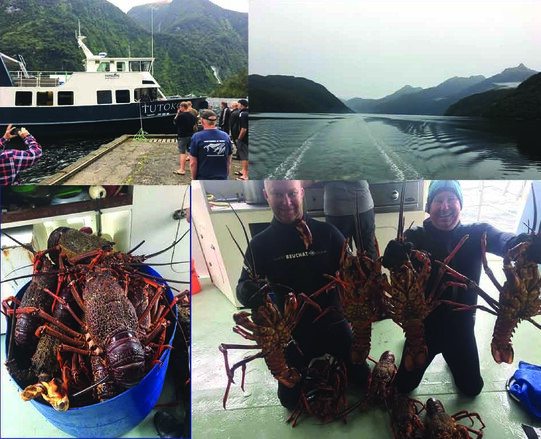Diving with Fiordland Expeditions
It was 12 very excited blokes who departed Auckland to head off for one of those “bucket list” trips that we all really really want to do one day – Fiordland! Probably the remotest, most untampered with part of New Zealand. Extraordinary scenic beauty – both above and below the waves. Peaceful like no other part of New Zealand. A true step back in time
We arrived in Queenstown and set off in our chartered bus to Te Anau. A stunning drive itself with the Remarkables and Lake Wakatipu scenery changing to distant mountain range and pasturelands before arriving in Te Anau.
An overnight stay was required with a very early morning departure down to Lake Manapouri where we met with Lila Of Fiordland Expeditions as we boarded our first boat. We crossed the lake as the sun came up and on arriving at the other side, boarded a bus to take us back down to sea level and meet with Tutoko II in Doubtful Sound.
The underwater environment in the fiords is intriguing and unique. This is due to the protection of the status as marine reserves and also because of an interesting effect of the high rainfall in the area. As rainfall drains through the lush forests, it becomes stained with tannins until it is the colour of strong tea. This dark freshwater does not mix with the sea water of the fiords, but sits on top. This limits the amount of light that reaches into the depths and therefore restricts almost all of the marine life to the top 40 metres of water depth. This 40m band is calm, very clear and relatively warm - home to sponges, corals and fish of sub-tropical, cool water and deep-water varieties. As a result, light sensitive species that normally live at great depths are found much closer to the surface and this gives divers the opportunity to see rare species such as the red and black corals at relatively shallow depths.
The fiords support the world's biggest population of black coral trees - about seven million colonies, some of them up to 200 years old. They are home also to brachiopods; primitive clam-like animals that have been bypassed by evolution, remaining unchanged in over 300 million years. Bottlenose dolphins, New Zealand fur seals, Fiordland Crested Penguins and little penguins are also resident in the fiords.
To say we had a blast would almost be an understatement. Our first day we dived in Doubtful Sound before heading out to the Tasman and back into Breaksea Sound. We cut through Acheron Passage and into Dusky Sound for our second day and hung out thereafter. We spent our four days relaxing and enjoying the environment and choosing when we felt like another dive – in between eating. The dives were phenomenal. With visibility on each dive at least 20m once you got under the tannin layer of freshwater. It was a weird sensation initially descending through this tannin layer as there was almost zero visibility and then exploding to 20 metres of beautiful clear water. On the first dive I saw three seven gill sharks and crazy amounts of large red spiny lobsters. Everything seemed to be huge in size – anemones, sponges, tube worms, sea cucumbers and the kinas were soccer ball sized. The impression of diving in an untouched and undiscovered environment was very real. We saw loads of the renowned black corals and at very shallow depths. The water temperature in March was between 18 and 19 degrees between the surface and down to 25 metres.
Generally, there is excellent quantities and variety of sea life in the fiords including blue cod (yum yum), schooling terakihi, giant butterfish, schools of butterfly perch. We saw plenty of New Zealand Fur Seals (almost once extinct but making a comeback). We also saw numerous Trumpeter fish and Blue Moki. The seven gill sharks were amazingly docile and inquisitive with us enjoying a number of close encounters.
Diving from the boat was easy, with the skipper putting us right on every spot and with little surfaced swimming required. Pick ups were good with a short swim out away from the reef and the skipper swinging in to pick us up. Swimming out from the reef was a little bit disconcerting when you had it in your mind that underneath you was 300 metres and with the tannin layer, you couldn’t see anything below. It kept you mindful to hang onto your gear as to drop it would be to kiss it goodbye.
With the competitiveness that prevailed between our group, we spent a lot of our dives catching crays – all aiming to see who could get the biggest. With plenty sized between 7 and 8 pounds, the biggest caught was mine at 9.3 pounds. Darrell was almost gracious in his defeat. And no – we didn’t bring them all back with most of our catch being released to swim another day. We chose to all bring one crayfish and a couple of good tails home and we had a couple of feeds while on board.
All in all, we were extremely well catered for onboard with Lila cooking and hosting our team of hungry blokes. We seriously didn’t feel underfed at all and the quality was excellent. The cabins are really comfortable and roomy enough. And there is no shortage of fresh water so showering is easy.
The end of the trip culminated with our helicopter ride directly from the boat out of Scupper Cove. The flight back to Te Anau was 35 mins of spectacular scenery.
Highly recommended trip – if you don’t have it on your bucket list, put it there! And then do it!! Here's a link to our next trip to Fiordland: Fiordland | Dive Zone Whitianga

